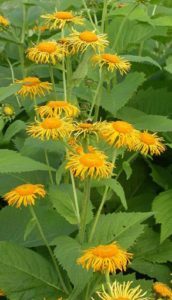Table of Contents
Herb—Elecampane (Inula Helenium)
Alias names for Elecampane: Inula Helenium, Family: N.O. Compositae also Asteracceae, Aunée, Alant, Alantwurzel , Aster helenium, Aster Officinalis, Aunée, Aunée Officinale, Echter Alant, Elf Dock, Elfdock, Elfwort, Enula Campana , Enule Campagne, Grande Aunée, Helenio, Helenium grandiflorum, Horse-Elder, Horseheal, Indian Elecampane, Inula helenium, Inula, Inule Aulnée, Inule Aunée, Inule Hélénie, Marchalan, Œil-de-cheval, Scabwort, Velvet Dock, Wild Sunflower, Yellow Starwort. The botanical name derives from the Helen of Troy legend.
Chinese Names for Elecampane: None found
Pictures of Elecampane:

Elecampane (Inula helenium)
References for Elecampane picture: https://hermionesgarden.blogspot.com/2011/02/inula-helenium-elecampane.html
About Elecampane:
Elecampane is a 4-5 foot tall perennial that grows on a rigid erect stem that is deeply furrowed. The plant branches near the top with pointed leaves that are 1-1.5 feet long and four inches across the middle where they are velvety underneath. The 3-4 inch diameter yellow flowers bloom from June-August and resemble a double sunflower. Inula helenium is notably prized by the Romans for food and medicinal purposes. Elecampane is native to western Asia and Europe but has been spread to now grow in many temperate parts of the globe including areas in the United States. It can be grown from seed in the spring or by root division in the fall. The plant grows best in shady, well drained but moist soil. The root is harvested in the fall and used fresh or dried at high temperatures for later use.
Actions and Historical Uses for Elecampane:
- Alterative (a substance used to favorable influence the outcome)
- Antiseptic
- Astringent
- Bronchitis
- Chest complaints/infections
- Colds
- Coughs (soothes)
- Diaphoretic (something that makes the body sweat)
- Digestive problems
- Diuretic (helps release retained water from the body)
- Eliminates worms
- Emphysema
- Expectorant
- Gentle stimulant
- Infection
- Loosens phlegm (mucolytic)
- Menopause
- Mildly bitter (so helping with gallbladder issue)
- Night sweats
- Tonic
How Elecampane is used and how it Works:
Elecampane has mucilaginous qualities from the inulin composition which helps to sooth the bronchial lining while the alantolactone is anti-inflammatory and stimulates the immune system and reduces mucus production. It is a stimulant, expectorant which aids in removing excess mucus from the lungs.
- Elecampane Decoction for irritable coughs
- Elecampane Tincture for bronchitis
- Elecampane Syrup for coughs
Parts of the Elecampane Plant Used:
- Fresh or Dried Root
Properties of Elecampane:
Anti-Inflammatory, Antiseptic, Diaphoretic, Digestive Stimulant, Diuretic, Eliminates Worms, Expectorant, Increases Sweating, Mildly Bitter, Sooths Cough, Stimulant, Tonic.
Chemical Constituents of Elecampane:
Alantol, Alantolactone, Alantolic acid, Dammaranedienol, Inulin, Polyacetylenes, Sesquiterpene lactones, Sterols, Triterpene saponins, Volatile oil
Contraindications, safety issues, concerns, harmful drug interactions and allergy precautions for Elecampane:
Elecampane can cause skin reactions and should not be used internally during pregnancy or nursing.
Helpful Links and References for Elecampane:
- https://www.webmd.com/vitamins-supplements/ingredientmono-2-elecampane.aspx?activeingredientid=2&activeingredientname=elecampane
- https://www.botanical.com/botanical/mgmh/e/elecam07.html
- https://en.wikipedia.org/wiki/Elecampane
- https://www.globalhealingcenter.com/natural-health/lung-cleansing-benefits-elecampane/
Key Words for Elecampane: elecampane, inula helenium, family n.o. compositae also asteracceae, aunée, alant, alantwurzel , aster helenium, aster officinalis, aunée, aunée officinale, echter alant, elf dock, elfdock, elfwort, enula campana , enule campagne, grande aunée, helenio, helenium grandiflorum, horse-elder, horseheal, indian elecampane, inula helenium, inula, inule aulnée, inule aunée, inule hélénie, marchalan, Œil-de-cheval, scabwort, velvet dock, wild sunflower, yellow starwort, about elecampane, picture of elecampane, what elecampane is used for, side affects of elecampane, uses of elecampane, parts of elecampane used, when to harvest elecampane, pic of elecampane, elecampane side effects, benefit of elecampane, elecampane herb, elecampane pregnancy, elecampane root, elecampane tincture, elecampane tea, elecampane plant, how to take elecampane, nutritional value of elecampane, health benefit of elecampane, elecampane plant, elecampane powder, elecampane oil, elecampane leaf, elecampane flower, common elecampane